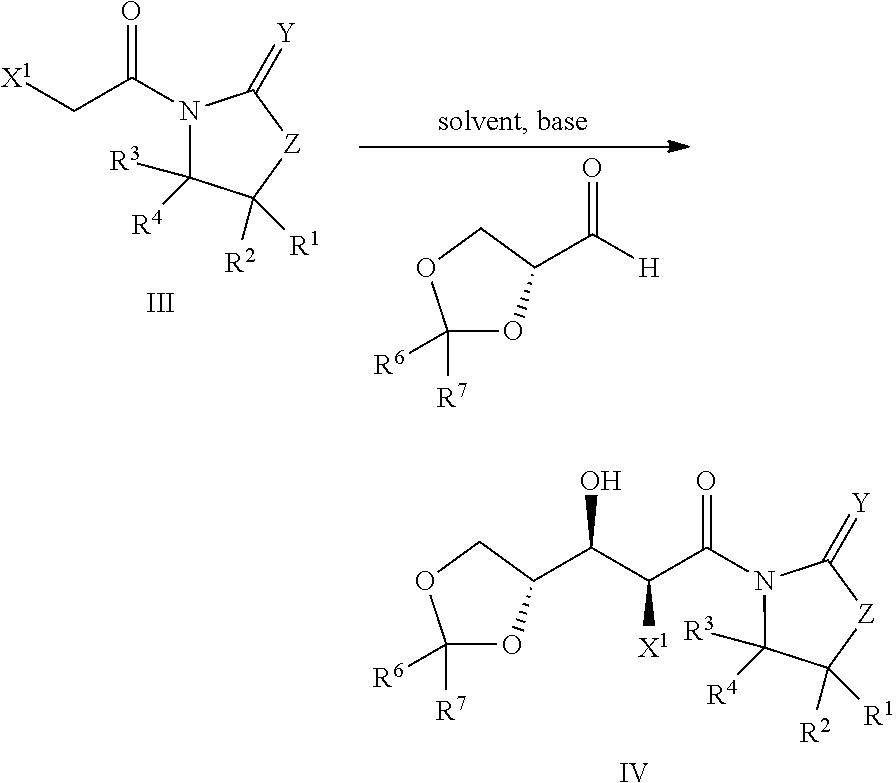Processes for preparing 2-dihalo ribolactones
a technology of ribolactone and dihalo ribolactone, which is applied in the field of methods for preparing 2dihalo ribolactone, can solve the problems of presenting a threat to environmental health, no approved therapies for yfv treatment are available, and 30,000 deaths a year
- Summary
- Abstract
- Description
- Claims
- Application Information
AI Technical Summary
Benefits of technology
Problems solved by technology
Method used
Image
Examples
specific examples
[0269]Specific compounds which are representative of this invention were prepared as per the following examples and reaction sequences; the examples and the diagrams depicting the reaction sequences are offered by way of illustration, to aid in the understanding of the invention and should not be construed to limit in any way the invention set forth in the claims which follow thereafter. The present compounds can also be used as intermediates in subsequent examples to produce additional compounds of the present invention. No attempt has necessarily been made to optimize the yields obtained in any of the reactions. One skilled in the art would know how to increase such yields through routine variations in reaction times, temperatures, solvents and / or reagents.
[0270]Anhydrous solvents were purchased from Aldrich Chemical Company, Inc. (Milwaukee, Wis.) and EMD Chemicals Inc. (Gibbstown, N.J.). Reagents were purchased from commercial sources. Unless noted otherwise, the materials used ...
example 1
Method 1 2-Cl Up, 2-F Down
Synthesis of 2-Deoxy-2-fluoro-2-chloro-3,5-di-O-(tert-butyldimethylsilyl)-D-ribono-lactone
[0271]
(S)-4-benzyl-3-(2-chloroacetyl)oxazolidin-2-one (2)
[0272]
[0273]To a solution of (S)-4-Benzyl-2-oxazolidinone, 1 (5 g, 28.2 mmol) in dry THF (150 mL) at −78° C. under N2 was added BuLi (2.5 M in hexane, 13.5 mL, 33.9 mmol). The solution was stirred at −78° C. for 15 min. and chloroacetyl chloride (2.47 mL, 31.0 mmol) was added in one portion. After full conversion was observed (typically 30 min.), the reaction was quenched by addition of a saturated aqueous solution of NH4Cl and allowed to reach room temperature. The mixture was diluted with EtOAc, washed with water and brine. The organic layer was dried over MgSO4 and concentrated under reduced pressure. The remainder was purified over silica gel column chromatography to afford a colorless syrup, which crystalized after standing to afford a white solid of 2 after filtration (5.1 g, 71%). Alternatively, precipitat...
example 2
Method 2—2-Cl Up, 2-F Down
[0288]
Ethyl 2-chloro-3-((R)-2,2-dimethyl-1,3-dioxolan-4-yl)-3-hydroxypropanoate (9)
[0289]
[0290]Ethyl chloroacetate (5 g, 40.8 mmol) was added to a solution of LDA (1 M in THF / hexane, 53 mL, 53.0 mmol) in dry THF (300 mL) at −78° C. under N2. After 15 min stirring, freshly distilled (R)-2,2-dimethyl-1,3-dioxolane-4-carbaldehyde (6.1 mL, 49.0 mmol) was introduced to the mixture and the reaction was stirred for an additional hour at −78° C. The reaction was quenched with HCl 1M at −78° C. The mixture was extracted with ethyl acetate, washed with water, brine, dried over MgSO4 and concentrated in vacuo. The crude product was purified by flash column chromatography (hexane / ethyl acetate 9:1 to 8:2) to afford compound 9 (4.8 g, 47%) as a diastereomeric mixture which was used directly in the next step.
Ethyl (3R)-3-((tert-butyldimethylsilyl)oxy)-2-chloro-3-((R)-2,2-dimethyl-1,3-dioxolan-4-yl)propanoate (10)
[0291]
[0292]To a solution of compound 9 (1.5 g, 5.9 mmol) i...
PUM
| Property | Measurement | Unit |
|---|---|---|
| temperature | aaaaa | aaaaa |
| temperature | aaaaa | aaaaa |
| temperature | aaaaa | aaaaa |
Abstract
Description
Claims
Application Information
 Login to View More
Login to View More - R&D
- Intellectual Property
- Life Sciences
- Materials
- Tech Scout
- Unparalleled Data Quality
- Higher Quality Content
- 60% Fewer Hallucinations
Browse by: Latest US Patents, China's latest patents, Technical Efficacy Thesaurus, Application Domain, Technology Topic, Popular Technical Reports.
© 2025 PatSnap. All rights reserved.Legal|Privacy policy|Modern Slavery Act Transparency Statement|Sitemap|About US| Contact US: help@patsnap.com



